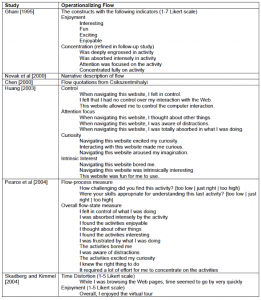83 Flow Theory
Flow Theory
What is Flow Theory?
Flow Theory was developed by Csikszentmihalyi (1975). The theory suggests that learners can experience optimal learning when they perform tasks characterized by a skills-challenge balance and by a person’s interest, control, and intense focus.
Key Concepts and Dimensions
Skills-challenge Balance
Flow requires a skill-challenge balance, which means that the skills are neither overmatched nor underutilized to meet a given challenge. The skill-challenge balance is dynamic. A person will incrementally improve his/her skill levels when performing the tasks, which, therefore, requires the person to engage in new challenges to match their increasing skills (Hektner & Csikszentmihalyi, 1996, p. 4).
Attention
The undivided attention to a task may be the clearest sign of flow. It is found that intentionality of focused attention is crucial to flow experience (Egbert, 2003), while intentional focused attention impedes flow (Abbott, 2000). In Csikszentmihalyi’s words (1975): [H]e is aware of his actions but not of the awareness itself.
Interest
Research suggests that individuals are very likely to develop an interest when their abilities, needs, and desires of an individual mesh with the attributes of a task (Deci, 1992). This echoes the concept of skills-challenge balance. Flow Theory associates learner interest with affect and posits that some level of anxiety is needed for learners to experience flow (McQuillian & Conde, 1996; Schmidt, Boraie, & Kassabgy, 1996).
Control
The opportunity for learners to exercise control while learning is essential in experience flow (Jackson & Marsh, 1996). However, learners are not inherently autonomous and they need help to gain independence in their learning environment (Thanasoulas, 2000).

Adapted from (Egbert, 2003)
Measurements
There are various approaches for measuring flow. We will need to operationalize flow in different ways to collect data from various learning contexts in order to answer our unique research questions. Finneran and Zhang (2005, p. 95) have provided a nice summary of how flow is operationalized in major empirical studies:

Another measure for flow is Flow Perceptions Questionnaire from Egbert (2003). This questionnaire consists of 14 items in the Likert format, having a 7-point scale. This measure has been used in foreign language learning environments (Mirlohi, Egbert, & Ghonsooly, 2011).
References
Abbott, J. (2000). “Blinking out” and “having the touch”: Two fifth-grade boys talk about flow experience in writing. Written Communication, (17), 53-92.
Csikszentmihalyi, M. (1975). Beyond boredom and anxiety. San Francisco: Jossey-bass.
Deci, E. L. (1992). The relation of interest to the motivation of behavior: A self-determination theory perspective. In K. A. Renninger, S. Hidi & A. Krapp (Eds.), The role of interest in learning and development (pp. 43-70). Hillsdale, NJ: Lawrence Erlbaum Associates.
Egbert, J. (2003). A study of flow theory in the foreign language classroom. The Modern Language Journal, 87, 499-518.
Finneran, C. M., & Zhang, P. (2005). Flow in computer-mediated environments: Promises and challenges. Communications of the Association for Information Systems, (15), 82-101.
Hektner, J., & Csikszentmihalyi, M. (1996). A longitudinal exploration of flow and intrinsic motivation in adolescents. The Annual Meeting of the American Educational Research Association, New York.
Jackson, S. A., & Marsh, H. W. (1996). Development and validation of a scale to measure optimal experience: The flow state scale. Journal of Sport and Exercise Psychology, (18), 17-35.
McQuillan, J., & Conde, G. (1996). The conditions of flow in reading: Two studies of optimal experience. Reading Psychology: An International Quarterly, (17), 109-135.
Mirlohi, M., Egbert, J., & Ghonsooly, B. (2001). Flow in translation: Exploring optimal experience for translation trainees. Target. International Journal of Translation Studies, 23(2), 251-271.
Schmidt, R., Boraie, D., & Kassabgy, O. (1996). Foreign language motivation: Internal structure and external connections. In R. Oxford (Ed.), Language learning motivation: Pathways to the new century (pp. 9-56). Manoa: University of Hawaii Press.

